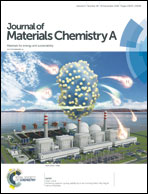Proton-conducting phosphate glass and its melt exhibiting high electrical conductivity at intermediate temperatures†
Abstract
A working hypothesis to design proton-conducting phosphate glasses exhibiting high proton conductivity and high stability was proposed. In this hypothesis, the precursor glass before electrochemical alkali-proton substitution (APS) is required to fulfill the terms of (i) the concentration of NaO1/2 in the precursor glass needs to be higher than 35 mol%, (ii) the O/P ratio of the glass composition cannot exceed 3.5, (iii) the glass network modifier oxides need to consist of cations with low electronegativity, (iv) the glass must contain a sufficient amount of glass network modifiers and intermediate oxides, such as alkaline-earth oxides, Al2O3, Y2O3, La2O3, WO3, Nb2O5, and Ta2O5, (v) the glass needs to consist of more than four or five components, and (vi) the glass must contain a small amount of GeO2 and/or B2O3. Based on the proposed working hypothesis, we obtained a 36HO1/2–4NbO5/2–2BaO–4LaO3/2–4GeO2–1BO3/2–49PO5/2 glass (36H-glass) by APS. While the glass transition temperature of 36H-glass was 179 °C, the glass, accurately the super cooled liquid, was stable for a long time up to 280 °C under fuel cell operating conditions and exhibited 1 × 10−3 S cm−1 at 280 °C, indicating that the developed working hypothesis is useful to design new proton-conducting electrolytes that work at intermediate temperatures.



 Please wait while we load your content...
Please wait while we load your content...